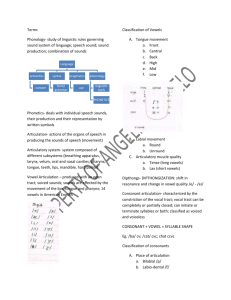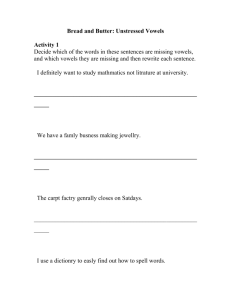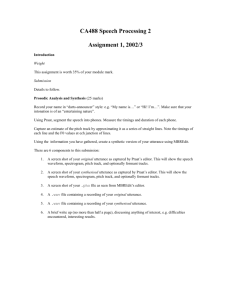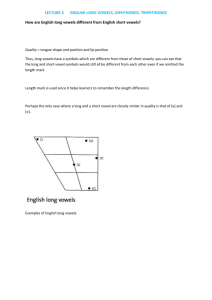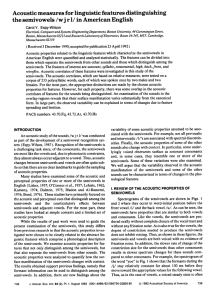Speech Science II
advertisement
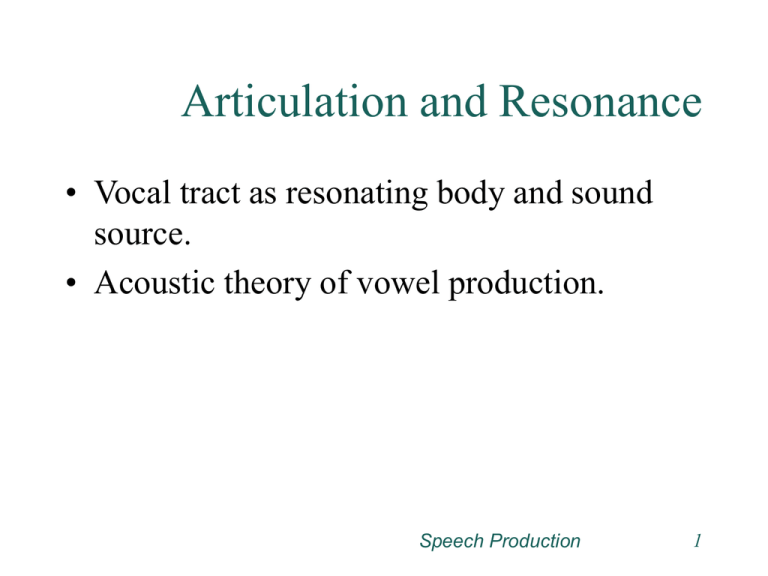
Articulation and Resonance • Vocal tract as resonating body and sound source. • Acoustic theory of vowel production. Speech Production 1 Basic Anatomy Review Speech Production 2 Basic Anatomy Review Speech Production 3 Basic Anatomy Review Speech Production 4 Vocal tract as resonating body and sound source. • Phonation sound source is VF vibration. • Vocal tract is 1/4 wavelength resonator – 17 cm long in the average adult male. – Open end is mouth and closed end is vocal folds. – There are a number of secondary 1/4 wavelength resonators due to changes in tube diameter. Speech Production 5 Speech Production 6 Acoustic (Source) Theory of Vowel Production • Source • Filter Speech Production 7 Source • Source of all vowels is vocal fold vibration • Source creates fo and harmonics • Harmonics are attenuated with an increase in frequency Speech Production 8 Speech Production 9 Filter • Filters modify the intensity of harmonics • Remember… The vocal tract a 17 cm 1/4 WL resonator and has a primary resonant frequency of 500 Hz & secondary resonant frequencies at 1500 and 2500 Hz. • Transfer function shows effects of vocal tract resonance. Speech Production 10 • Insert figure 4.62 Speech Production 11 Interaction between source and filter • In real world there are additional resonances which interact in vowel production. • Every time you change vocal tract configuration you change resonant peaks. • You also have radiation effect which results in 6 dB/octave increase in high frequencies. • All these factors interact to produce a vowel. Speech Production 12 Interaction between source and filter Speech Production 13 • In above example resonant peaks are labeled F1, F2, & F3. These are known as formant frequencies. • Formant frequencies can be displayed on a Spectrogram which shows frequency on ordinate and time on abscissa. 14 Speech Production English Speech Sounds • • • • • • • • Vowels & Diphthongs Semivowels Nasals Stops Fricatives Affricates Sound Influence Suprasegmentals Speech Production 15 Vowels • Vowels classified by tongue and mandible position. • High front vowels • Low back vowels • High back vowels Speech Production 16 High Front Vowels • Include • Tongue placed high and forward in vocal tact • Mandible somewhat closed • High oral constriction Speech Production 17 Low back vowels • Tongue constriction occurring to the rear of vocal tract • Mandible opening is wide. Pharyngeal constriction is greater than other vowels. Speech Production 18 High back vowels • Tongue constriction in back of vocal tract. • Mandible is somewhat closed. • Lips are somewhat protruded. Speech Production 19 Vowel Quadrilateral Speech Production 20 Vowels may be displayed showing formant frequencies Speech Production 21 Spectrograms of Some Vowels Speech Production 22 Diphthongs • Vowels of changing resonance • On next slide we have examples of diphthongs. Notice how F1 and F2 transitions between first and second vowel. Speech Production 23 Speech Production 24 Speech Production 25 Diphthongs (continued) • Peterson and Lehiste call shorter diphthongs Tense Monophthongs. These include diphthongs found in “bay and boat” • Longer diphthongs are those found in “find, bout, boy” Speech Production 26 Semivowel production • Four semivowels /w, j, r, l/ • Similar to vowels because they are highly resonant. • Considered to be consonants because they function in language to release the vowel or diphthong. E.g., “swim” is possible “swm” is not. Speech Production 27 Semivowels (continued) • Two classes of semivowels… – Glides /j, w/ – Liquids /l, r/ Speech Production 28 Semivowels (continued) • Glides… – are so named because the formants glide to and from adjacent vowels. Very similar to a diphthong except it has a much faster transition. – In terms of place of production … • /j/ is considered a palatal glide • /w/ is labial glide Speech Production 29 Speech Production 30 Semivowels (continued) • Liquids… – Involve placing tongue tip either close to or near the alveolar ridge. – /r/ - tongue tip does not touch alveolar ridge while airflow passes centrally through a grooved tongue. – Some dialects omit /r/ – /w/ for /r/ substitution is common since /w/ is easier to produce. Speech Production 31 Semivowels (continued) • /l/ - tongue tip touches alveolar ridge while airflow passes laterally. • In initial position /l/ is produced as speaker releases the tongue. • In the final position it is of long duration. • /l/ of long duration are sometimes referred to as a “dark /l/” Speech Production 32 Speech Production 33 Nasals • Include /m/, /n/, and /ng/ • Anti-resonances … need to discuss prior to actual nasal production. – Opposite of resonance. Attenuates a range of frequencies. – All nasals have anti-resonances which are a result of a cul-de-sac formed by closed vocal tract. Speech Production 34 Speech Production 35 Nasals (continued) • Place of articulation has a direct effect on size of cul-de-sac and anti-resonant frequency. • The place of artic and anti-resonant frequency for each nasal is as follows . . . Speech Production 36 Nasals (continued) • Other characteristics include … – All air passes through nasal cavity. – Because air passes through nasal cavity (longer pathway than oral tract) you have a lower resonant frequency than non-nasals. – Nasals have relatively low intensity, especially for upper formants. Speech Production 37
